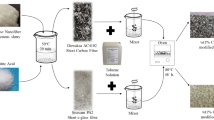Abstract
Non-woven composites were produced using kenaf (bast) fiber and polypropylene (PP) fiber. The effects of needle punching process, number of needle and kenaf fiber loadings on the properties of non-woven composite were studied. The aspect ratio of kenaf fiber was also measured in this study. The aspect ratio of most of kenaf fiber used was in the range of 200–400. The results indicated that the mechanical strength of the non-woven composite was significantly influenced by the percentage of kenaf fiber. This may due to the evenly mixed kenaf and PP fibers during carding process prior to the mechanical interlocking by needle punching process. The tensile strength, modulus and toughness were enhanced with the incorporation of carded and needle punched fibers. The number of needle used in needle punching process had a significant effect on the strength of the composite. This was evident in SEM micrograph where composite prepared from carded to needle punched non-woven web showed better wettability as compared to composite prepared from carded non-woven web only. However, no significant difference was observed in water absorption and thickness swelling tests for composites prepared with different number of needles.














Similar content being viewed by others
References
Mohanty AK, Misra M, Drzal LT (2002) Sustainable bio-composites from renewable resources: opportunities and challenges in the green materials world. J Polym Environ 10(1):19–26
Mohd Ishak ZA, Yow BN, Ng BL, Khalil HPSA, Rozman HD (2001) Hygrothermal aging and tensile behavior of injection-molded rice husk-filled polypropylene composites. J Appl Polym Sci 81(3):742–753
Stark NM, Rowlands RE (2003) Effects of wood fiber characteristics on mechanical properties of wood/polypropylene composites. Wood Fiber Sci 35(2):167–174
Rozman HD, Tay GS, Kumar RN, Abubakar A, Ismail H, Mohd Ishak ZA (1999) Polypropylene hybrid composites: a preliminary study on the use of glass and coconut fibre as reinforcement in polypropylene composites. Polym-Plast Technol Eng 38(5):997–1011
Rozman HD, Tan KW, Kumar RN, Tay GS, Abubakar A (2000) Oil palm empty fruit bunch polypropylene composites -The effect of modified Alcell Lignin as a compatibilizer on tensile properties. Int J Polym Mater 46(1):195–204
Rozman HD, Tay GS, Kumar RN, Abusamah A, Ismail H (2001) Polypropylene-oil palm empty fruit bunch-glass fibre hybrid composites: a preliminary study on flexural and tensile properties. Eur Polym J 37(6):1283–1291
Rozman HD, Tay GS, Kumar RN, Abusamah A, Ismail H, Mohd Ishak ZA (2001) The effect of oil extraction of oil palm empty fruit bunch on the mechanical properties of polypropylene-oil palm empty fruit bunch-glass fibre hybrid composites. Polym-Plast Technol Eng 40(2):103–115
Rozman HD, Zuliahani A, Tay GS (2010) The effects of rice husk (RH) particle size, glass fiber (GF) length, RH/GF ratio and addition of coupling agent on mechanical properties and physical properties of polypropylene-RH-GF hybrid composites. J Appl Polym Sci 115(6):3456–3462
Tay GS, Zaim JM, Rozman HD (2010) Mechanical properties of polypropylene reinforced with oil palm empty fruit bunch pulp. J Appl Polym Sci 116(4):1867–1872
John MJ, Anandjiwala RD (2009) Chemical modification of flax reinforced polypropylene composites. Compos A Appl Sci Manuf 40(4):442–448
Rahman MR, Huque MM, Islam MN, Hasan M (2008) Improvement of physico-mechanical properties of jute fiber reinforced polypropylene composites by post-treatment. Compos A Appl Sci Manuf 39(11):1739–1747
Clemons C (2002) Wood-plastic composites in the United States: the interfacing of two industries. For Prod J 52(6):10–18
Rozman HD, Peng GB, Mohd Ishak ZA (1998) The effect of compounding techniques on the mechanical properties of oil palm empty fruit bunch-polypropylene (EFB-PP) composites. J Appl Polym Sci 70(13):2647–2655
Hargitai H, Rácz I, Anandjiwala R (2006) Development of hemp fibre-PP nonwoven composites. In: Macromolecular symposia, vol 239. John Wiley and Sons, pp. 201–208
Akil HM, Omar MF, Mazuki AAM, Safiee S, Ishak ZAM (2011) Abu Bakar A Kenaf fiber reinforced composites: a review. Mater Des 32:4107–4121
Rowell RM, Stout HP (1998) Jute and kenaf. In: Lewin M, Pearce EM (eds) Handbook of fiber chemistry, 2nd edn. Marcel Dekker, New York
Chanda M, Roy SK (1997) Plastics technology handbook, expanded edn. Marcel Dekker, New York
Rozman HD, Saad MJ, Mohd Ishak ZA (2003) Modification of oil palm empty fruit bunches with maleic anhydride: the effect on the tensile and dimensional stability properties of empty fruit bunch/polypropylene composites. J Appl Polym Sci 87(5):827–835
Acknowledgments
The authors would like to thank Universiti Sains Malaysia, Penang, Malaysia for the research grant (1001/PTEKIND/814037) that has made this research work possible.
Author information
Authors and Affiliations
Corresponding author
Rights and permissions
About this article
Cite this article
Rozman , H.D., Shannon-Ong, S.H., Azizah, A.B. et al. Preliminary Study of Non-woven Composite: Effect of Needle Punching and Kenaf Fiber Loadings on Non-woven Thermoplastic Composites Prepared From Kenaf and Polypropylene Fiber . J Polym Environ 21, 1032–1039 (2013). https://doi.org/10.1007/s10924-013-0599-6
Published:
Issue Date:
DOI: https://doi.org/10.1007/s10924-013-0599-6




